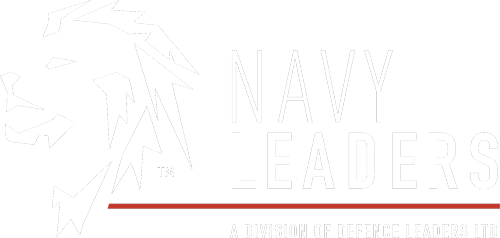REPMUS 2024: A Glimpse Into The Future Of Naval Warfare
)
“We have to unleash creativity and we have to be courageous. If something fails, we can’t just stop. If something fails, costs money, we have to accept that as part of the process.”
With these words Admiral Henrique Eduardo Passaláqua de Gouveia e Melo, Chief of the Naval Staff, Portuguese Navy summed up the ethos that has seen REPMUS become the world’s largest and most complex Maritime Unmanned Systems (MUS) exercise.
REPMUS stands for Robotic Experimentation, and Prototyping with Maritime Unmanned Systems. From its infancy in 2010 it has grown into an event this year involving 23 nations as active participants, with a further seven more observing.
In fact REPMUS 2024 has involved around 2,000 participants, along with 20 ships and roughly 700 separately staged events.
Navy Leaders attended the three-week event’s media day in Troia yesterday (Tuesday) to learn more about some of the topics that this year’s exercise has been focusing upon.
The day began with a welcome and introductory words from representatives of the European Defence Agency (one of the co-organisers), and from Portuguese Fleet Commander Vice Admiral Nuno Chaves Ferreira.
Then followed an enlightening talk by Captain Antonio Mourinha, the director of the CEOM base at Troia that was the locus and command and control (C2) centre for the majority of the REPMUS activities.
Among the many excellent points highlighted by Capt Mourinha was the observation that one pressing need was to find ways of saving energy used in underwater data processing and storage. Already, he noted, globally data transfer used roughly the same amount of energy as commercial aviation, and these demands were only set to grow rapidly in the months and years to come.
Among the targets of research going on at REPMUS 2024 was finding innovative ways of reducing the energy demands of servers and computers underwater by around 60%, not least via experiments conducted on CEOM’s new artificial island, named Prince Henry the Navigator and moored close to Setubal Canyon not far from CEOM at Troia.
Then followed the opportunity to witness some of unmanned aerial systems taking off on surveillance sorties, and to talk to some of the industry stakeholders involved in carrying out some of the multi-domain operations staged throughout the three-week event.
Among the numerous highlights was a chance to get a close-up look at Schiebel’s Camcopter S-100 unmanned Vertical Take-Off and Landing (VTOL) drone, with a six-hour flight duration, a 200km range, and an operational ceiling of 18,000 feet.
The Unmanned Aerial Vehicle (UAV) can be used for classic Intelligence, Surveillance and Reconnaissance (ISR) missions, but also to drop sonobuoys and sensors that can be used in Anti-Submarine Warfare (ASW).
This last capability tied in neatly with another of REPMUS 2024’s key focus areas: the concept of an ASW Barrier. Essentially, it involves the extensive use of MUS to detect, track and ultimately perhaps even seek to neutralise where necessary enemy submarines if they threatened naval bases, shipping lanes, or other elements of Critical Undersea Infrastructure (CUI).It was also fascinating to speak with Commander Marco Guimaraes of CEOV, the Portuguese Navy's Unmanned Vehicle Operational Experimentation Cell.
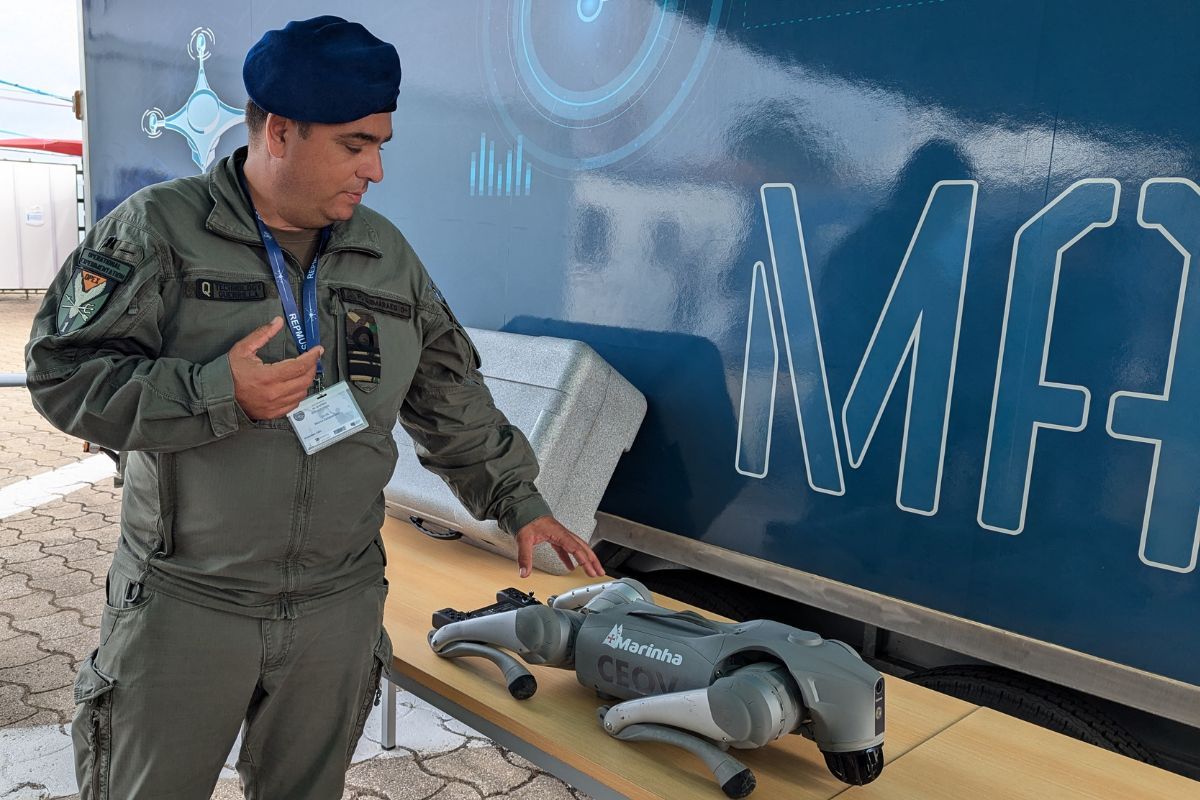 He introduced us to a range of unmanned systems his team has been designing, evaluating and testing, including “Espuma”, a robotic dog with a LIDAR scanning radar system mounted on its nose that can mount stairs, jump, and crouch, and can be used to explore new environments without putting a human in harm’s way. The dog’s name means “sea foam” and was named after a Portuguese water dog well-known in Portugal.
He introduced us to a range of unmanned systems his team has been designing, evaluating and testing, including “Espuma”, a robotic dog with a LIDAR scanning radar system mounted on its nose that can mount stairs, jump, and crouch, and can be used to explore new environments without putting a human in harm’s way. The dog’s name means “sea foam” and was named after a Portuguese water dog well-known in Portugal.
Cdr. Guimaraes explained that Espuma was one of the Commercial Off-The-Shelf (COTS) systems that CEOV also evaluates as part of its role, although the balance is closer to 80% in-house design and testing and 20% COTS evaluation.
He added: “The question is always, ‘What is the mission?’ We are a small navy and we need to use resources wisely. Can I get the answer directly from the market?”
Cdr. Guimaraes also told how his team had developed a system it called “CEOV TV” that amalgamated video feeds from all the unmanned assets being operated by the different navies at REPMUS and then broadcasted them to all the users who needed them: a shining example of interoperability in action.
Perhaps most excitingly, he also spoke at length about the Portuguese Navy’s new concept currently in development of a “drone mothership” surface vessel that can be equipped with a variety of modular unmanned systems depending on a given mission’s parameters.
The vessel will be able to accommodate a mission-bespoke mixture of aerial, surface and underwater unmanned assets; it is hoped that this new craft will be in the water and undergoing testing as soon as 2026.
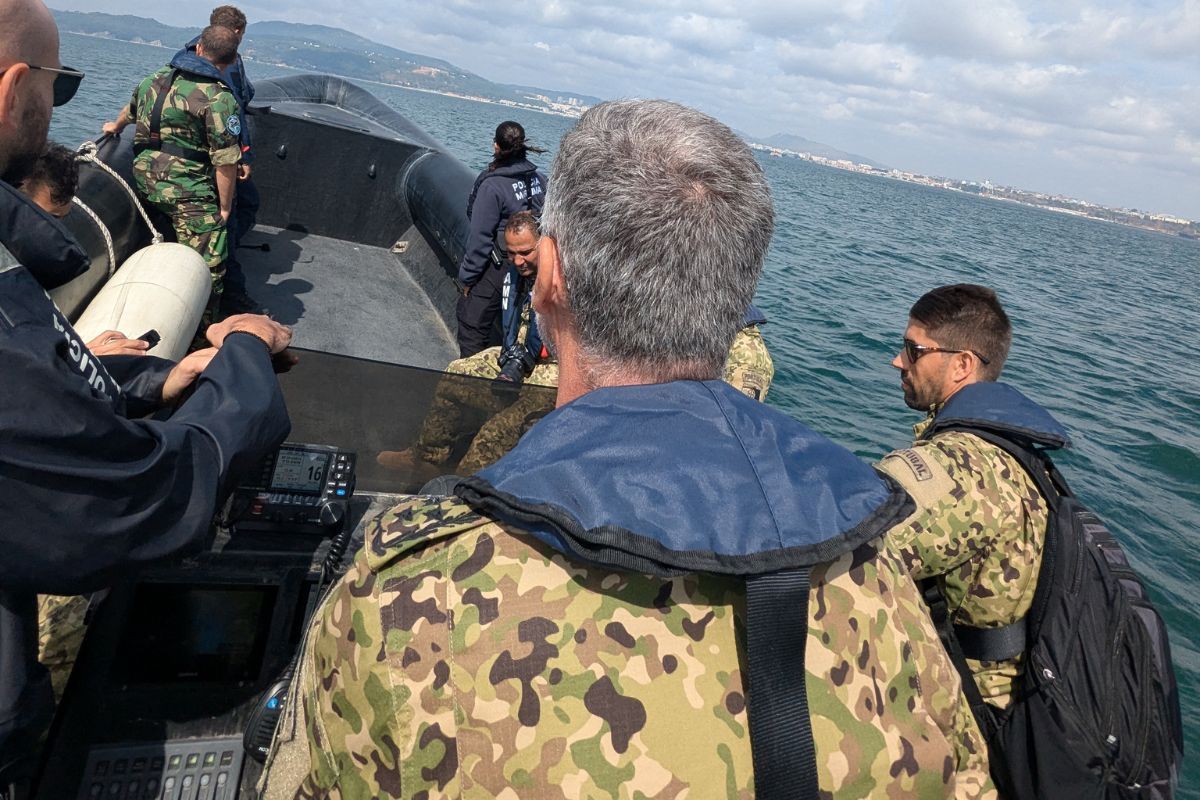 After several more illuminating chats with other navy and industry partners who have been busy testing and refining their systems, it was time to head across from CEOM to Forte de Cavalo at nearby Sesimbra, courtesy of an exhilarating 30-minute ride on two rather rapid boats. At times we hit speeds in excess of 55 knots — quite the experience!
After several more illuminating chats with other navy and industry partners who have been busy testing and refining their systems, it was time to head across from CEOM to Forte de Cavalo at nearby Sesimbra, courtesy of an exhilarating 30-minute ride on two rather rapid boats. At times we hit speeds in excess of 55 knots — quite the experience!
At Forte de Cavalo we had a presentation from Commander Stefan Pahl of the German Navy, attached to the NATO Naval Mine Warfare Centre of Excellence.
He related how over the course of this year’s three-week REPMUS exercise they had been staging no fewer than 26 separate missions involving 221 people and 62 separate unmanned assets, with representatives from NATO’s Centre for Maritime Research and Experimentation (CMRE) on hand to validate and evaluate the results.
As Cdr. Pahl reflected, unmanned systems still required a lot of actual people to oversee, task, and analyse how good a job the robots were doing!
Nevertheless he was confident that the work he and his colleagues were doing was very much shaping the “transition into the future” of naval mine warfare.
He observed: “Our task is to find these things and make them safe…And the most crucial thing in finding these mines is time. We have to be as fast as possible, and as efficient as possible.”
Cdr. Pahl cited as one example of how a collaborative approach could pay dividends an exercise between three different navies that had reduced the estimated mission time from 12-14 hours down to 2.5 hours in practice.
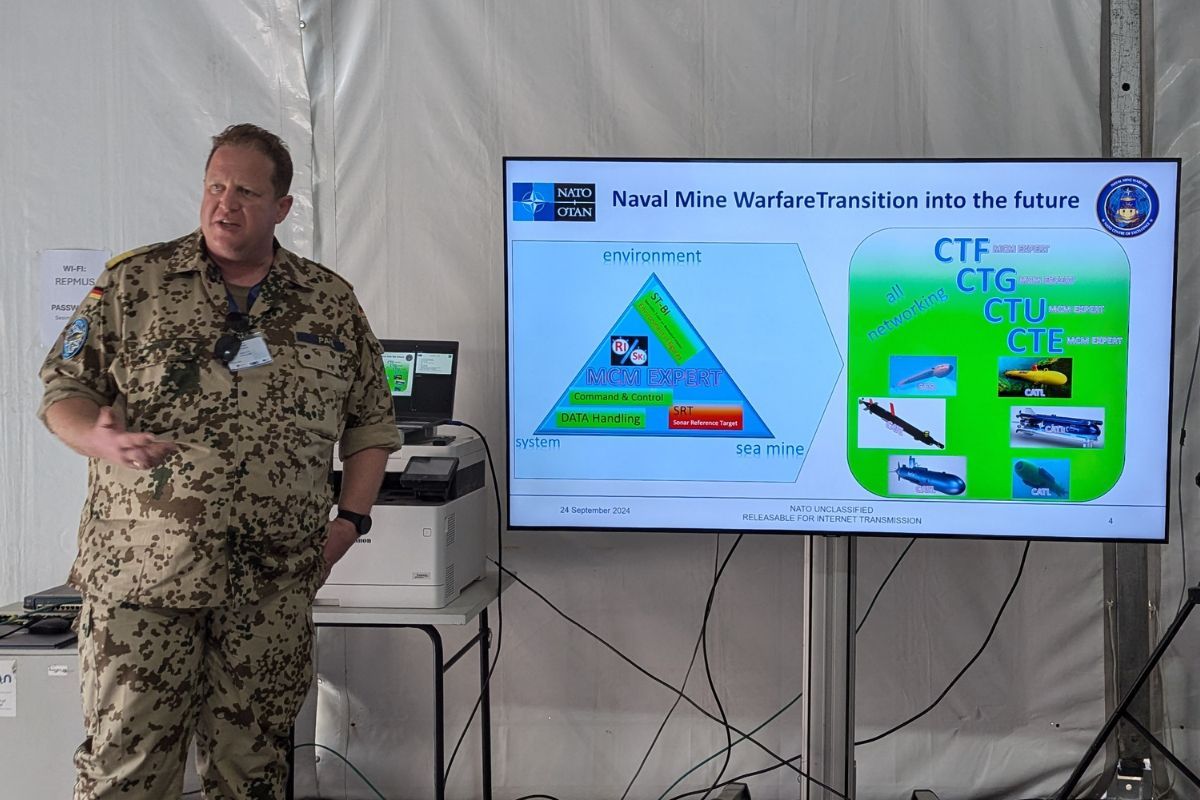 Among the many focuses of experimentation were C2 for MUS-driven operations; protection of CUI; MUS swarming; mine location via change-detection; graphical representations of risk assessment for speedy communication; and buried and floating object detection, classification, and tracking.
Among the many focuses of experimentation were C2 for MUS-driven operations; protection of CUI; MUS swarming; mine location via change-detection; graphical representations of risk assessment for speedy communication; and buried and floating object detection, classification, and tracking.
In summary, Cdr Pahl concluded: “Data is not everything, but without data, everything is nothing.” What was needed, he said, was improved interaction, standardised communication as the key to interoperability, and refined international coordination mechanisms.
He said automatisation technology was the way to reduce workload and improve efficiency while keeping humans in the loop for decision-making where necessary.
He continued: “What is the benefit? One, we take the human out of the ‘danger zone.’ Two, we increase efficiency and effectiveness.”
After the mine warfare presentation there was a further chance to take a close look at many more of the unmanned systems which have been put to the test at REPMUS 2024, including a Kongsberg Unmanned Underwater Vehicle (UUV) capable of diving to 3,000m and staying submerged for up to six days at a time, and a host of smaller UAVs, UUVs and remotely-operated camera platforms with side and bottom-scanning sonar arrays.
A team from Naval Group (NG) Belgium were also there with a proof-of-concept aerial drone specifically designed to detect floating mines: a task easier to accomplish from the air than by surface or underwater vessels.
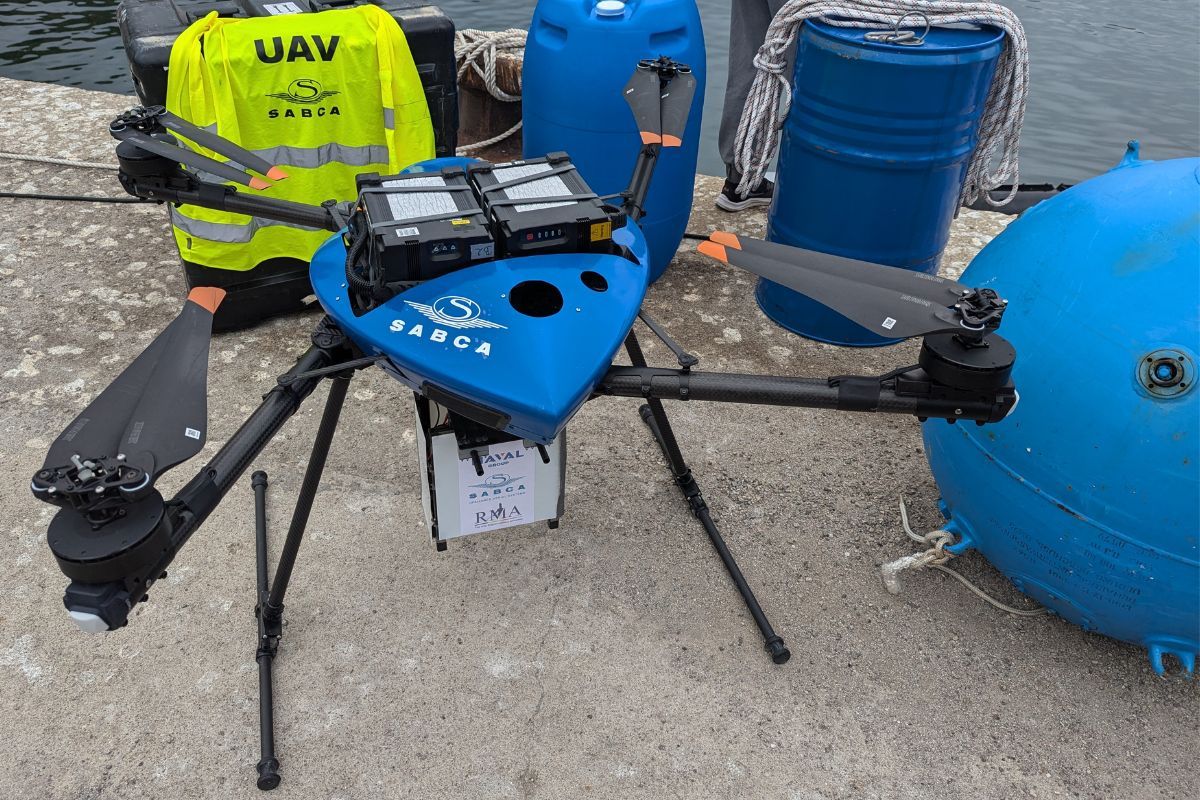 Aymeric Moullart de Torcy, responsible for Unmanned Systems & Cyber Marketing at NG, explained the idea was to detect surface-floating mines from the air using a multi-spectral system.
Aymeric Moullart de Torcy, responsible for Unmanned Systems & Cyber Marketing at NG, explained the idea was to detect surface-floating mines from the air using a multi-spectral system.
The VTOL drone the group was using at REPMUS 2024 could take a 6kg payload and the detection system it was trialling had proved successful at locating floating mines — no easy task when you consider they’re generally painted blue and sit only just proud of an undulating surface in a vast ocean.
Now the initial proof-of-concept groundwork had been done, M. de Torcy said, the next steps would be to develop and hybrid rotor and fixed-wing system that could stay in the air for longer, up to 10 hours at a time, and to add more capabilities to the drone itself in terms of on-board classification and perhaps even in time, mine neutralisation.
All too soon the day drew to a close and it was time to hop back into the fast boats for another whirlwind, wave-bouncing 30-minute ride back to CEOM.
All in all, the media day did a fantastic job of showcasing in just a few short hours the wealth of research and development work that has been going on off the coast of Lisbon over the last three weeks.
And it served as a superb demonstration of just how valuable and relevant the REPMUS exercise is in a sector of the defence industry whose relevance is becoming ever more central across domains of warfare.
The way it manages to straddle the sweet spot between creative innovation and real-world application is just one of the reasons why Navy Leaders is teaming up with REPMUS to become a partner of the event.
As Admiral Melo himself observed: “If creativity is completely free it ceases to be useful, it’s too much originality.
“Our task is to organise the creativity so that we have an end. It is a balance between freedom and thinking and sharing ideas, and also: ‘What are the aims, and how can we use it in the real world?’”
#REPMUS24 #NavyLeaders #WeAreNATO #MaritimeUnmannedSystems #Strongertogether #Innovationtechnologies #InnovationNATO #CUI
